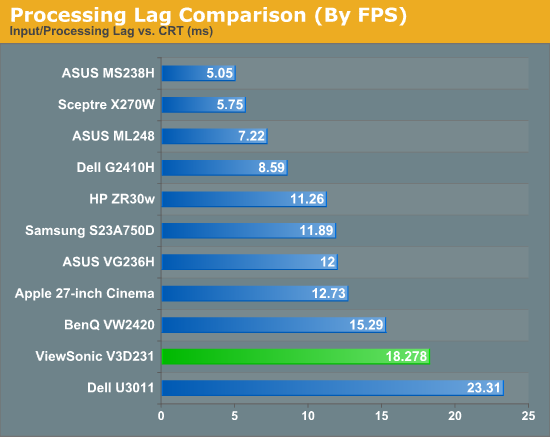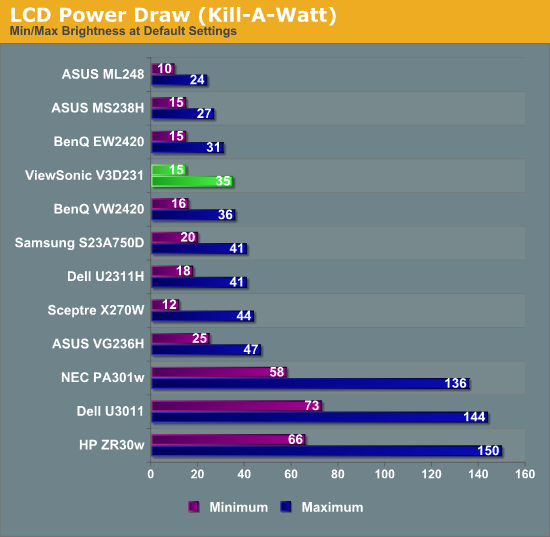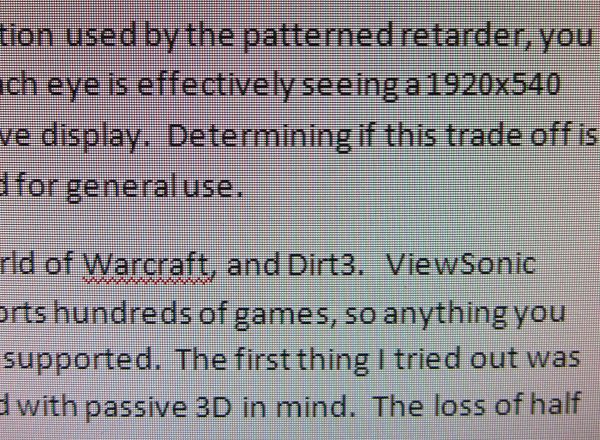ViewSonic V3D231 3D Display - The Passive Approach
by Chris Heinonen on December 30, 2011 12:00 AM ESTOf course anyone buying this ViewSonic monitor is going to be buying it for 3D use as well. As I touched upon earlier, passive 3D has some advantages over active 3D, including cheaper glasses. The main advantage in my view is that I find it far easier to watch and enjoy than active 3D. For people like myself, the opening and closing of the lenses in active 3D glasses leads to headaches and discomfort in a short period of time, and we generally avoid it. Passive 3D has none of that since your lenses are always open. This also allows more light to pass through than with an active 3D display. Additionally the technology used in passive 3D should virtually eliminate any ghosting or crosstalk in the 3D image.
Unfortunately, passive 3D does have one major downside: due to the polarization used by the patterned retarder, you only get half the effective vertical resolution from a display. Each eye is effectively seeing a 1920x540 image instead of a 1920x1080 image as you would with an active display. Determining if this tradeoff is worth it requires trying out both types of display, both for gaming and for general use. Examples of text from this review can be seen below, both with and without the glasses between the camera and screen.
For gaming tests, I relied on three main games: Half Life 2, World of Warcraft, and DiRT 3. ViewSonic provides the TriDef 3D software with the monitor that supports hundreds of games, so anything you have from the past few years has a very good chance of being supported. The first thing I tried out was World of Warcraft, and this was certainly not a game designed with passive 3D in mind. The loss of half the resolution renders the text unreadable, which is a big no-no in an MMORPG or other genre with lots of reading. During normal gameplay it was fine, but you can’t read anything that is on the screen while in 3D mode and wearing the glasses.
Half-Life 2 and DiRT 3 prove to be much better examples for the V3D231, as there is a good sense of depth in the rendering and not much in the way of artifacts. You still see some ghost objects, but I found the glasses much easier to wear and use than any active 3D glasses. The TriDef software allows for you to adjust the sense of depth and other 3D parameters in game, which lets you determine what is easiest to view. Objects that appear to come out of the screen, instead of going back into the screen, can often cause more eye strain and fatigue, so if you find yourself getting tired you can reduce the level of depth in the image to compensate. While I think that 3D can add something to the experience, passive 3D does add a lot of aliasing due to the loss of vertical resolution, and I feel that a 120Hz refresh rate made for a more natural, immersive experience than passive 3D does.
For watching movies, passive 3D is a tossup once again. The recent 3D Blu-ray release of The Lion King looked just fantastic. Crosstalk and ghosting were practically non-existent I found, and the loss of resolution really didn’t bother me much with the animation. However, as soon as I put on the 3D Blu-ray of Tron Legacy, I found myself wishing for an active 3D display. The combination of black backgrounds and bright, angled lines led to aliasing all over the image and was really quite distracting. Tron is my worst case disc for passive 3D, as it seems to show off the downsides more than anything else, and that is the case here.
Running crosstalk benchmarks, the ViewSonic seems to do much worse than the prior active 3D Samsung, but the results on the ViewSonic are incredibly dependent on my head angle and location. If I shift just an inch to the side I get totally different numbers, so I tried to maintain my head in the dead center. Since it is a passive display, the numbers seem much higher than they should be, but I made certain that every measurement was as accurate as I could make it.

For non-3D gaming, I put the ViewSonic through the usual lag tests, with both faster and regular response enabled. I found no differences between the modes in testing, so there is only one set of numbers presented here. The ViewSonic averages just about 1 frame of lag in comparison to the ViewSonic CRT next to it. I had no issues using it for general gaming, but people that need better response will want to look at some other options.

Hooked up to the Kill-A-Watt, the ViewSonic maxes out at 35 watts with a full backlight, and 15 watts with the backlight at minimum. This is higher than other TN displays with LED backlights and closer to IPS or VA panels. Given the higher power usage I wish the light output had been higher than it is.













42 Comments
View All Comments
pandemonium - Friday, December 30, 2011 - link
I was happy to see a review from AT for a Viewsonic monitor - it's been a long time since the last one - until I saw it was this one in particular. I'm not big on 3D display technology.I definitely enjoy seeing the test bundle you guys throw at displays!
Samus - Friday, December 30, 2011 - link
There is a reason Active 3D costs more. Passive 3D sucks outside of a movie theater with a 3DLP projector. Technical explaination aside, Passive 3D will always be a poor choice for viewing on an LCD screen. But it is significantly cheaper and the glasses are cheaper and lighter.But Active 3D is superior in resolution, viewing angles and overall experience at home.
Headaches tend to be one of those things where if you get them with Passive, you'll get them with Active, and vice-versa. It isn't the shutter speed that causes the headaches, its the trick the image is playing on the brain. The shutter speed is too fast to notice. You can't even blink fast enough to catch it if you tried. 120hz is faster than you think.
UpSpin - Friday, December 30, 2011 - link
I completely disagree. For me active is useless and passive is superior. If you get headache with passive you'll get with active, too. if you get headaches with active you won't necessarily get with passive.At the side the retina can dissolve more images in a shorter time. Thus if you use active shutter glasses it might look ok at the front, but at the sides of your eye you always see the flicker, causing headaches.
It's also wrong that active is more expensive, contrary, it's cheaper. You can use a traditional LCD with a high refresh rate and only have to add the active shutter glasses (PS: This technology is from pre 2000 or earlier, my ASUS graphics card had this shutter glasses already, which worked with CRT monitors with a high refresh rate just as good as current LCD)
If you want to make a good passive display, you have to double the resolution, and use two special polarizers, one of the most expensive parts of a display. And if you want a good one, you have to use circular polarizers.
This display is so cheap because it uses the cheapest parts available, poor TN panel, low resolution, probably linear polarizers, ...
marc1000 - Friday, December 30, 2011 - link
Indeed, this technology is from earlier than 2000. I had ACTIVE glasses on my first gaming console, a MASTER SYSTEM 8bit console. This is 1990 or so... long before first gen playstation...it worked with ANY crt television (no LCD at that time), and did have really slow refresh rates (mostly 24fps, blinking the glasses at 12fps each eye), using the interlaced nature of TVs at the time.
So you could see the closing and opening of the lenses if you tried too. The only game I played was pretty simple (Blade Eagle 3d) but that 3d really worked.
It worked so well that i'm pretty critic at seeing 3d movies and 3d TVs. The only TV that provided a experience similar to the one I had in childhood was an active type - passive 3d like in movie-theathers and the new TVs is not even near as godd.
JarredWalton - Friday, December 30, 2011 - link
120Hz panels are more expensive generally speaking, and active glasses are substantially more expensive than polarized glasses. Ergo, active displays are "more expensive". Unless you can find me a 120Hz panel that costs less than the passive equivalents, I'll stand by the statement that active 3D costs more.UpSpin - Saturday, December 31, 2011 - link
120Hz displays are available already, 1920x2400 not (which is a requirement to get the same resolution in 3D) and those will be more expensive. Active glasses are cheap to produce, just two simple LC, not more, and you can mass produce them because they can work with other models, too. Active displays don't get more expensive than 2D display with increasing size, the important part, glasses, don't need a change. Passive however becomes more expensive, because the two additional circular polarizers in the panel must get larger, too, and you need new one for each model.So in the end, for an active system, you only need a currently mainstream 120+Hz display and a not so expensive to manufacture active glasses.
For passive you need a LC panel with twice the resolution, two opposite circular polarizers which must fit to each individual pixel and the glasses with two additional polarizers.
The reviewed display is the only display I know which currently uses the passive approach in the mainstream. It's not comparable with active displays, because this reviewed model uses the cheapest parts available (poor panel, low 3D resolution, ...) and doesn't offer the quality of active models, thus a price comparison is stupid, because they aren't comparable. Wait for a 1920x2400 IPS passive 3D display. Oh, it isn't available? Mh, what could be the reason? Too expensive yet, maybe?
Active is the cheapest full color 3D option, passive will be the future(almost all 3D cinemas use it already), it isn't yet, because of money.
You're right, active 3D costs more for you at the moment, but because no real higher quality passive 3D displays are available yet, so a comparison is impossible.
grammatonF - Saturday, December 31, 2011 - link
I think the point is that the passive reviewed here uses a 60hz screen and makes no attempt to double the vertical resolution and so the end result is VASTLY INFERIOR to active shutter. I've used active shutter since 2004 at least since Nvidia have supported it for a long time. Never had headaches nor have I noticed flicker.I can agree that a hypothetical passive 3d system using a screen with double vertical res would be better. But then why bother with that when glasses-free 3d is almost upon us.
The "3d monitor" on review here is inferior to active shutter 3d. Do I want a 3d system with vertical res so bad I can't see small text? No way!
I will be purchasing my shutter glasses today. I've had an LG 120hz monitor for many months now. Cost £178. My friend got the same monitor used at BT shop for £135.
Bownce - Tuesday, January 10, 2012 - link
It's from WAAAY before 2000. It was available as a plug-in accessory for 3-D CAD design for the Atari Mega-ST business computers in the late 80's (working with a standard, CTR monitor).snarfbot - Saturday, December 31, 2011 - link
the best passive tech in terms of crosstalk is the dolby 3d, each lens filters out all frequencies of light except for 3 specific bandwidths in each primary color range.the projectors project through similar lenses of course one for each eye, it doesnt require a silver screen either.
microvision already has their pico laser projector on the market, so its just a matter of time until its scaled up for theater use. provided it can be made safe enough for the fcc. lasers can be sorta dangerous.
anyway it would be perfectly suited to the technology, considering it can output a specific wavelength in each primary band.
jconan - Sunday, January 1, 2012 - link
No, it's not the trick vision, it's that the 3D images aren't optimized for varying intra-ocular distances that vary by a few mm. There are quite a few studies out there on 3D imaging and viewer fatigue.